Site menu:
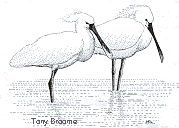
July 2016 Newsletter
Species Spotlight - Spoonbill.
Colour Ring Report.
June Bird News.
Forthcoming Events.
Latest Newsletter.
Species Spotlight - Spoonbill

https://elliotsbirdingdiaries.wordpress.com/
Spoonbills on the the Dee Estuary
The seven spoonbills which were at RSPB Burton Mere Wetlands on several dates in June 2016 was the largest number ever on the Dee estuary, and they were a fantastic sight feeding in the lagoons and perching on trees around the reserve. There was some indication of nest building activity with birds picking up sticks and leaves on the scrapes with some taking them into the trees, but as this involved immature birds this wasn't a serious breeding attempt - but may be in the future?
The previous
Dee Estuary record was six,
in 1998 at Inner Marsh Farm (although this included a ship
assisted Mauritian
Spoonbill so may be that count should really be five), and
in 2009 at Parkgate.
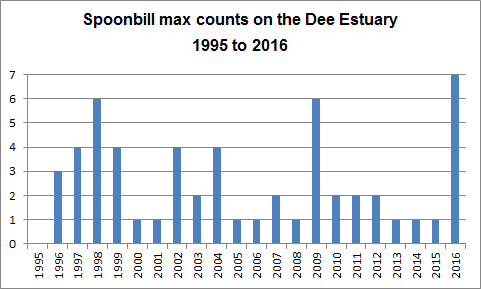
The first ever bird recorded here was on Burton Marsh about 1859, inevitably it was shot! There were just two records in the first half of the 20th century but from 1968 sightings became more frequent with birds seen in nine out of the 27 years prior to 1996. But 1996 was a remarkable year as there was a serious attempt to breed at nearby Frodsham Marsh with display, copulation and nest building with at least six birds present. To put this into perspective there had been no recorded breeding in the United Kingdom since the Seventeenth Century! Several of the Frodsham birds commuted between there and the Dee estuary including at Inner Marsh Farm and Parkgate, with some display and stick carrying noted at the former site.
Since 1996 they have been annual, but surprisingly, given the increase in counts elsewhere (see below), numbers have recently tailed off both in terms of max counts and also frequency of visits. But we are on the extreme western edge of their range so may be that is to be expected. Hopefully the recent influx heralds an era of increasing records.
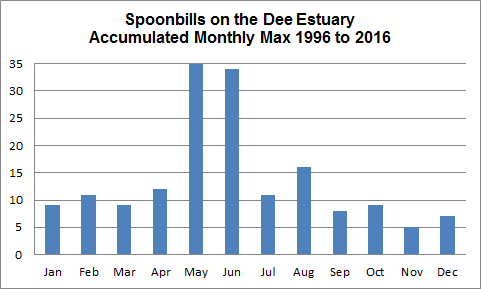
The three highest counts (two of six and one of seven) all occurred in May and June. As this is right smack in the middle of their breeding season it is no surprise that most birds arriving then are immatures and it is likely that the odd adults that also turn up are young ones who have failed to breed for one reason or another - they don't start breeding until they are at least three years old. Immature birds also predominate during the rest of the year as it is these that tend to stay nearest to the breeding grounds (mostly in the Netherlands) through the winter rather than migrate much further south as the adults do.
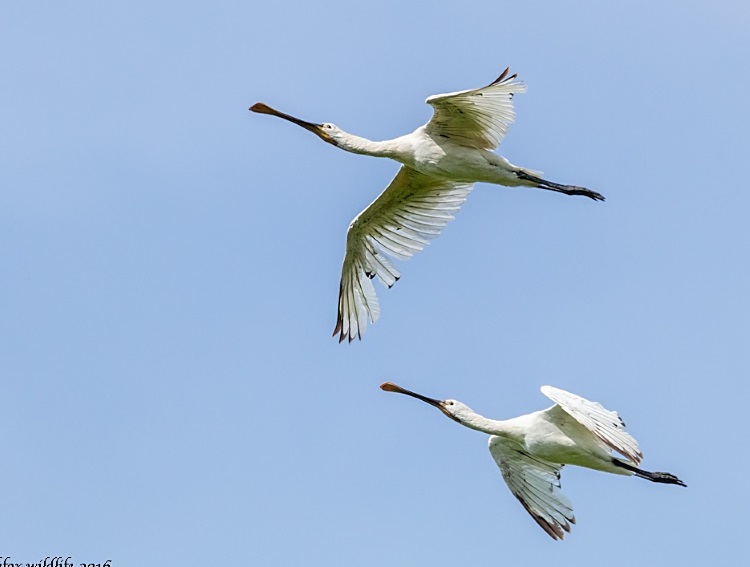
Spoonbills in the UK
Spoonbills did eventually breed, not too far away on the Ribble Estuary, with one pair successfully raising two young in 1999 - this was the first successful UK breeding in 330 years! Various attempts at nest building followed in several parts of the country but the next successful breeding was in Dumfries & Galloway in 2008. What followed was a step change in the colonisation of this species in the UK with the establishment of a colony at Holkham, in Norfolk, starting with six pairs producing 10 young in 2010, this had increased to 10 pairs and 18 young by 2013. I don't have any figures yet for the past three years but I understand the colony continues to thrive.

Another
exciting development over the past 10 years is the establishment of a
substantial over-wintering flock in Poole Harbour, Dorset. The graph
shows the sharp rise in the winter (Dec to Feb) max from 2006/07, there
was a dip during the cold winter of 2010/11 but it then reached a max
of 40 over the last
two winters. But that isn't the whole story as counts in Poole Harbour
actually peak during the post-breeding passage in October and there was
a record count for the UK of 60 there in October 2015. Colour-ringing
shows that the vast majority of the Spoonbills which visit Poole
Harbour are from the Dutch colonies, so far there is no evidence that
any birds from Holkham over-winter here - despite some claims to the
contrary.

The Spoonbills are doing what Spoonbills do best - sleeping! Look closely and you will see four of them are colour-ringed, these were all ringed in the Netherlands, three immatures and one adult.
Spoonbills - West European Population
The Eurasian Spoonbill (Platalea leucorodia) ranges from western Europe right across to south-east Asia comprising several sub-species/races/populations, but for the purpose of this article we will concentrate on the western European population, the majority of which breed in the Netherlands and Spain and winter as far south as West Africa - this population is also known as the East Atlantic Flyway Population. It is, of course, these birds which occur here in the UK.
After a long historical decline, reaching a low point in the 1950s and 1960s, there has been a strong increase in numbers with Dutch breeding numbers increasing from 148 pairs in 1968 to 2,534 pairs in 2012, and those in Spain increasing from 100 pairs in 1970 to 1500 pairs in 2007. In the past 30 years they have spread to breed in Belgium, Denmark, France, Germany, Portugal and the United Kingdom. This recovery has come about due to the protection of all the major breeding sites and sympathetic management of wetland habitats.
The population is currently thought to be at least 16,000 birds, of which about 80% winter in Mauritania and Senegal in west Africa, the rest staying in Europe, mainly France and Spain. Migration is a fascinating subject and there is still much we don't understand. In order to enhance our understanding the Spoonbill migration has been extensively studied with several thousand birds being colour-ringed since 1992. The conclusion of this study surprised everyone: Spoonbills that habitually winter in Africa (i.e. the majority) are worse off than Spoonbills that decide to go less far with both their survival and their reproductive success being lower. The species does seem to be in flux with increasing numbers wintering in Europe (including Poole Harbour - see above), but this change is taking place at a far slower rate than would be expected. I quote from the Royal Netherlands Institute for Sea Research website:
"This is caused by a combination of the fixed wintering habits of adult spoonbills and the 'traditional selection' of wintering grounds by young spoonbills that may follow adult spoonbills during migration and thus in many cases end up in West Africa as well."
You can find out more about this fascinating research by reading the papers and website articles listed below (references 8 to 11).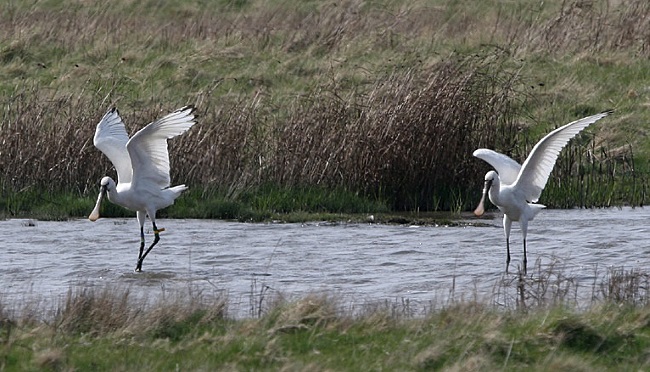
The left hand one is colour-ringed under the scheme described above, details of it's movements is given in the Colour Ring Report, below.
References/Sources of Information:
1. Colin Schofield, Attempted Breeding of Spoonbill in Cheshire - 1996, Cheshire and Wirral Bird Report 1996, CAWOS.
2. T. Hedley Bell, The Birds of Cheshire, Sherratt, 1962.
3. Cheshire and Wirral Bird Reports 1968 to 2014, CAWOS.
4. Holling et al., Rare breeding birds in the UK in 2008, British Birds September 2010, also Rare breeding birds in the UK Reports 2009 to 2013 published in British Birds and on-line, see http://www.rbbp.org.uk/.
5. Spoonbill records as reported to BirdGuides.6. Spoonbill records as reported to www.deeestuary.co.uk.
7. Stefanie Deinet et al., Wildlife comeback in Europe: The recovery of selected mammal and bird species, https://www.rewildingeurope.com/, 2013.
8. Lok, T. (2013) Spoonbills as a model system: a demographic cost-benefit analysis of differential migration. PhD Thesis, University of Groningen, Groningen, The Netherlands.
9. van Roomen M et al., Status of coastal waterbird populations in the East Atlantic Flyway 2014, Programme Rich Wadden Sea, Sovon, Wetlands International, BirdLife International & Common Wadden Sea Secretariat, 2015.
10. Royal Netherlands Institute for Sea Research, Conservative spoonbills are worse off, see:https://www.nioz.nl/news-detail/conservative-spoonbills.
11. Tamar Lok et al., The paradox of spoonbill migration: most birds travel to where survival rates are lowest, Animal Behaviour 82 (2011) 837 - 844.
Richard Smith.Colour Ring Report

Bottom right: Spoonbill GYflagG-BmL © Keith Scovell
Some historical records this month. We have
only just received feedback for two Black-tailed Godwits ringed on the
south coast of the UK and seen here in July 2015. The Spoonbill records
go a lot further back but I thought, given the Spoonbill article above,
they would be of interest as it demonstrates just how much the immature
birds move around. These two Spoonbills were both ringed as chicks on
the Frisian Islands, showing just how important the nature reserves are
on these largely unspoilt islands. Being large birds with
long legs reading their colour rings is nice and
easy, they can be read with a telescope up to 300 metres away
- one of the
reasons why this species was chosen for the migration study mentioned
above.
Black-tailed Godwits
ROB-GYG. Ringed at Iken on the River Alde, Suffolk, England, on October 17th 2014.Recorded at Gilroy Nature Park, West Kirby, on July 17th 2015.
B//R-YG.
Ringed on Farlington Marshes in Langstone Harbour, Portsmouth, on
October 15th 2013.
Recorded at Gilroy Nature Park, West Kirby, on July 16th and 17th 2015.
Spent
the first half of the 2013/14 winter in the Langstone and Chichester
harbours area. Feb 2014 saw it in Pagham Harbour in West Sussex.
2014/15 saw a similar pattern but it moved to the Blackwater Estuary,
Essex, in March, with the next record at West Kirby in July 2015.
Records since then were in West Sussex in Jan 2016 and on the
Blackwater Estuary in Mar and Apr 2016.
Spoonbills
GYflagG-BmL. Ringed on Schiermonnikoog, Frisian Islands, Netherlands, on June 10th 2007, as a nestling.Jun 2007 to Aug 2007 - Netherlands.
Nov 2007 to Mar 2008 - Devon.
Apr 2008 - Kent.
May 2008 - Norfolk.
Jun 2008 - Netherlands.
Jul to Aug 2008 - Suffolk and Norfolk.
Oct 2008 to Apr 5th 2009 - Devon.
Apr 13th and 14th 2009 - Inner Marsh Farm and Burton Marsh.
Note that in both autumns and winters it was recorded in Devon but in each case there was a gap of at least two months between records suggesting that it may have flown on to somehere else during mid-winter, perhaps France?
Black (D) - Black (H) (black rings with yellow letters). Ringed on Terschelling, Frisian Islands, Netherlands, on June 5th 1992, as a nestling.
Jun to Aug 1992 - Netherlands.
Jun 1995 - France.
Aug to Sep 1995 - Netherlands.
Oct 1995 - France.
Apr 1996 - Spain.
May 4th 1996 - Lincolnshire.
May 6th to May 19th 1996 - Frodsham Marsh and Dee Estuary.
Aug 1996 - Netherlands.
Oct 1996 and Apr 1997 - France.
From Oct 1997 to Oct 1999 it was recorded four times in the Netherlands and twice in France.
Above data was taken from David Norman's article "Movements of A Colour-ringed Spoonbill" published in the Cheshire and Wirral Bird Report 2000. This bird was recorded over 50 times from when it was ringed until Oct 1999, so the above is just a brief summary.
Richard
Smith and Matt Thomas.
The
Spoonbill in the photograph was recorded by Steve Seal, John Kirkland
and Keith Scovell. As there was so much interest with the attempted
breeding in Cheshire in 1996 a large number of people saw the second
Spoonbill.
June Bird News
Some birders call June a 'dead' month. I've never subscribed to that view and this year it has been far from dead with some great birds.
The month started with a large flock of
migrating Sanderlings with 700 at Gronant, you can well imagine their
next stop will have been Greenland - these will have flown up from
Africa, and at that late date may be as far as from South Africa. The
3rd saw the arrival of seven Spoonbills as described in the article
above - altogether there were four reports of seven birds through the
month and by the last week six seemed to have taken up residence in the
trees where the Little Egrets are nesting. Also on the 3rd there was a
count of 74 Avocet chicks - this is twice the previous record of 36 in
2012. Most years the Avocets have had a bit of a torrid time with
predation so lets hope this marks a change in fortune, but it's easy to
forget that they only started breeding here in 2006.
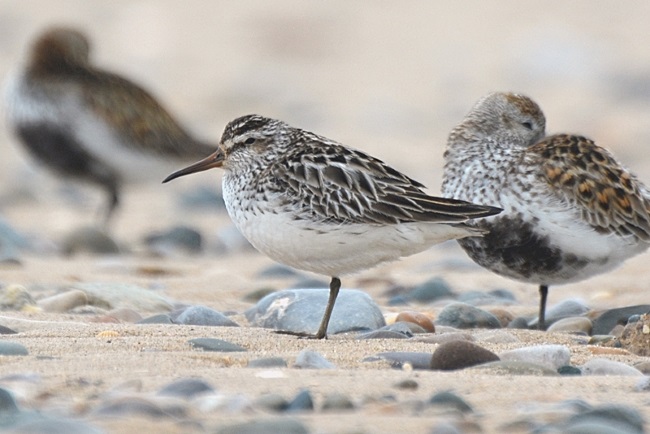
Gronant was in the news again with the arrival of a Broad-billed Sandpiper on the 11th, it was recorded on a further four dates through the month. The next day a Stone Curlew was spotted in the sand dunes, but this wasn't the first visit to Gronant for this vagrant as there was one here in June 2002.
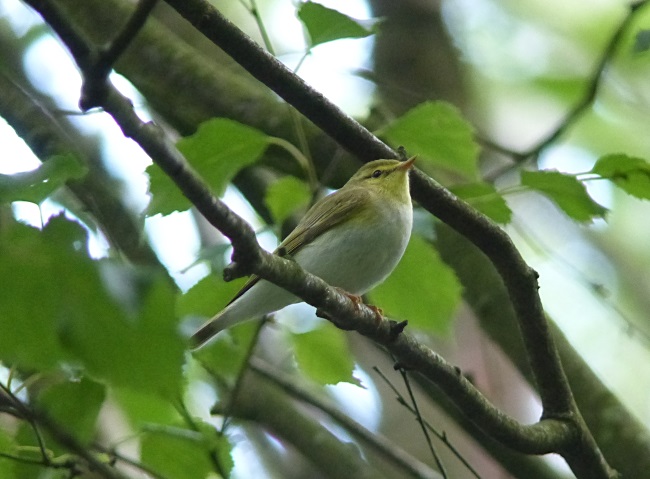
It is sad that Wood Warblers have become so rare in our area so it was good to have one singing away in Heswall Dales through the first two weeks of the month. Usually when a bird is singing in June you would expect them to be breeding but unfortunately it seems this was a lone male desperately trying to attract a mate.
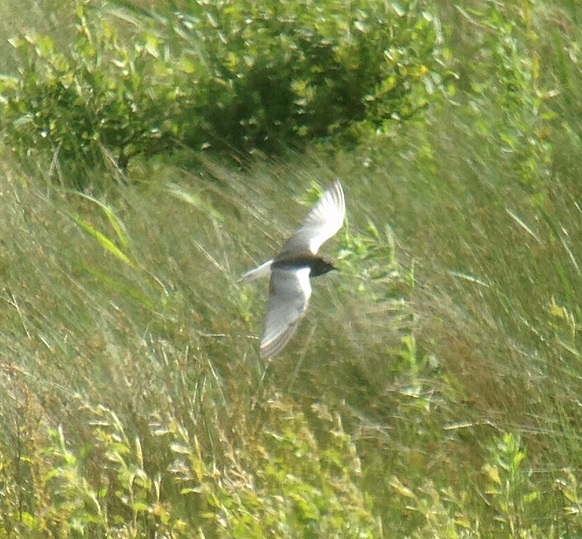
Next up was a White-winged Black Tern, an adult in breeding plumage, which did a tour of the head of the estuary on the 17th visiting Connah's Quay, Shotton Nature Reserve and Burton Mere Wetlands. The last one was a juvenile at Inner Marsh Farm in October 2010. A Spotted Crake was heard calling at Shotton Nature Reserve on the 20th, there's always the possibility they may have bred there. The last of what was a very good June for rarities was a Glossy Ibis at Burton Mere Wetlands on the 25th.
The Little Terns continue to do well at
Gronant and I understand there is yet another record high number of
breeding pairs and, with the low level of predation so far, things are
looking good for a bumper year for fledglings. The Common Terns at
Shotton are also doing well with an estimated 350 pairs, the same as
last year.

https://elliotsbirdingdiaries.wordpress.com/
Richard Smith.
What to expect in July
Heswall and Thurstaston are the best places to see Whimbrels and there were over 80 last year; look out also for spectacular numbers of Redshanks there. Less common waders will be Spotted Redshanks, Greenshanks, Common, Green and Wood Sandpipers with Burton Mere Wetlands, Connah's Quay and Parkgate favoured sites. We will be looking forward to the return of Black-tailed Godwits to Gilroy (West Kirby) with the first ones expected back by mid-month, over the past two years this small flooded field has become one of the most important sites in he country for this species where they gather to undertake post-breeding moult.
If we get some strong westerly winds sea-watching can be excellent with Manx Shearwaters, Gannets and skuas, quite a few non-breeding Common Scoters over-summer in Liverpool Bay with small flocks commonly seen off Gronant, and more rarely from Hilbre and North Wirral.
Top of Page
Forthcoming Events
July Highest Spring Tides (Liverpool)
Also
see Tides
page.
4th July, 11.43hrs (BST), 9.3m.
5th July, 12.32hrs (BST), 9.4m.
6th July, 13.18hrs (BST), 9.3m.
Forthcoming Events
Organised by the Wirral
Ranger Service , Flintshire
Countryside Service and the
RSPB (Dee Estuary):
All these events and walks have bird interest, even those not
advertised specifically for birdwatching. No need to book for these
events unless specified - please check below.
2pm to 4pm.
A guided tour around the Little Tern colony. A chance to ask questions aboutthe birds and why they travel 4000 miles to the edge of Prestatyn.
Meet at the Lower Gronant Car Park, SJ090836.
No need to book.
Friday 15th July, Bat and Owl night at Royden Park.
9pm to 11pm.
Join the Ranger on this evening stroll and discover where owls and bats live and hunt.
Wind/Waterproof clothing and stout footwear are essential.
Sorry no dogs.
Meet at the Coach House.
Booking essential.
For further information and to book contact midwirralrangers@wirral.gov.uk or ring 0151 648 4371.
Friday 15th July, Seabird Watch at Gronant.
2pm to 4pm.
A guided tour around the Little Tern colony. A chance to ask questions aboutthe birds and why they travel 4000 miles to the edge of Prestatyn.
Meet at the Lower Gronant Car Park, SJ090836.
No need to book.
Friday 22nd July, Sunset Walk to Hilbre Island.
6:00pm to 10:00pm
Join the Rangers and the Friends of Hilbre for a guided walk to Hilbre Island.
On the walk we will learn more about the amazing maritime history of the island and look for the wildlife, including Grey Seals that make the islands their home. There should be large numbers of terns to see flying around the island.
As we return from the island we hope to catch a special Dee estuary sunset.
There is a £3 charge per person with money raised going to conservation work on the islands.
Booking essential: email wcp@wirral.gov.uk or ring 0151 648 4371.
Please wear suitable footwear and bring a waterproof.
Meet by the Dee Lane slipway next to the Marine Lake car park.

Please note that the entrance for the above Hilbre talk is
free but
any donations for the Friends of Hilbre will be gratefully received.